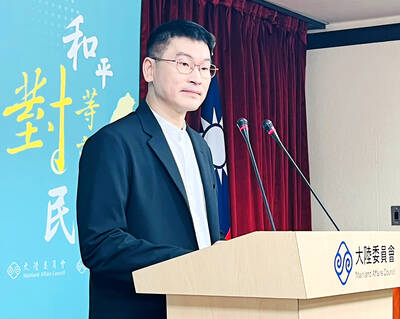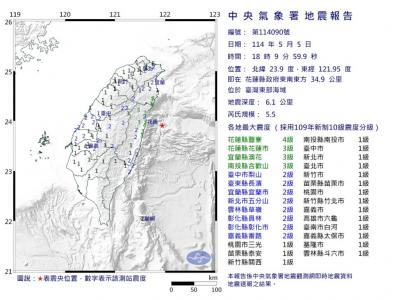An exhibition on the 228 Redress Movement that was led by late democracy pioneer Deng Nan-jung (鄭南榕) was launched in Taipei yesterday to commemorate the 70th anniversary of the 228 Incident and 30th anniversary of the movement’s inception.
The 228 Incident refers to an uprising in 1947 against the then-Chinese Nationalist Party (KMT) regime and the resulting brutal crackdown that left tens of thousands dead and led to nearly four decades of martial law.
Deng was imprisoned in 1986 without trial after then-Taipei city councilor Chang Te-ming (張德銘) accused him of swaying voters ahead of local elections by publishing articles in Deng’s Freedom Era Weekly magazine.

Photo: Chien Jung-fong, Taipei Times
Deng’s wife, former presidential office secretary-general Yeh Chu-lan (葉菊蘭), said at the exhibition’s opening ceremony yesterday that the first task Deng embarked on after his release from prison in 1987 was to seek repatriations for people who were killed in the massacre and oppressed during the White Terror era.
Shortly after his release from prison, Deng cofounded the 228 Peace Day Association and, during martial law, launched the first march advocating redress for those oppressed during the massacre, and for the government to designate Feb. 28 as a national holiday.
More marches followed, and as the following grew, Deng and other association members were frequently targeted by police officers, Yeh said.
“Thirty years later, everyone in the nation can speak freely about and research the 228 Massacre,” she said, calling the movement a “key” that unlocked the shackles placed on society during the White Terror era.
“Only when pain is remembered by the citizenry are history’s lessons learned. Only by learning the truth and understanding the past can Taiwan become a truly normalized and healthy nation,” she said.
“History should not be forgotten,” association cofounder Lee Sheng-hsiung (李勝雄) said.
Chiang Kai-shek (蔣介石) was the perpetrator of the 228 Massacre, Lee said, criticizing Chiang’s descendants, several of whom are politicians, for never apologizing for this atrocity.
Several people who were reported missing in the White Terror era are still unaccounted for, Lee said, urging surviving White Terror perpetrators and their descendants to come forward and explain what actually happened to those people and apologize so that they might be forgiven.
“The democracy people enjoy today is built on the tears, blood and sweat of democracy pioneers and countless broken families,” democracy movement pioneer Lin Tsung-cheng (林宗正) said.
This year’s 228 Incident commemorative events include a re-enactment of the 1987 Tainan march, which is being organized by National Cheng Kung University Student Union member Wu Hsin-ju (吳馨如).
To raise awareness of the 228 Incident, Wu has invited the public to participate in the march, which is to feature replicas of two banners and one sign used by Deng and association members.
The march is to take place on Feb. 28 at 2:28pm from Nanmen Florist Market in Tainan’s Nanmen Road and end at Tang Te-chang Memorial Park.

An essay competition jointly organized by a local writing society and a publisher affiliated with the Chinese Communist Party (CCP) might have contravened the Act Governing Relations Between the People of the Taiwan Area and the Mainland Area (臺灣地區與大陸地區人民關係條例), the Mainland Affairs Council (MAC) said on Thursday. “In this case, the partner organization is clearly an agency under the CCP’s Fujian Provincial Committee,” MAC Deputy Minister and spokesperson Liang Wen-chieh (梁文傑) said at a news briefing in Taipei. “It also involves bringing Taiwanese students to China with all-expenses-paid arrangements to attend award ceremonies and camps,” Liang said. Those two “characteristics” are typically sufficient

A magnitude 5.9 earthquake that struck about 33km off the coast of Hualien City was the "main shock" in a series of quakes in the area, with aftershocks expected over the next three days, the Central Weather Administration (CWA) said yesterday. Prior to the magnitude 5.9 quake shaking most of Taiwan at 6:53pm yesterday, six other earthquakes stronger than a magnitude of 4, starting with a magnitude 5.5 quake at 6:09pm, occurred in the area. CWA Seismological Center Director Wu Chien-fu (吳健富) confirmed that the quakes were all part of the same series and that the magnitude 5.5 temblor was

The brilliant blue waters, thick foliage and bucolic atmosphere on this seemingly idyllic archipelago deep in the Pacific Ocean belie the key role it now plays in a titanic geopolitical struggle. Palau is again on the front line as China, and the US and its allies prepare their forces in an intensifying contest for control over the Asia-Pacific region. The democratic nation of just 17,000 people hosts US-controlled airstrips and soon-to-be-completed radar installations that the US military describes as “critical” to monitoring vast swathes of water and airspace. It is also a key piece of the second island chain, a string of

The Central Weather Administration has issued a heat alert for southeastern Taiwan, warning of temperatures as high as 36°C today, while alerting some coastal areas of strong winds later in the day. Kaohsiung’s Neimen District (內門) and Pingtung County’s Neipu Township (內埔) are under an orange heat alert, which warns of temperatures as high as 36°C for three consecutive days, the CWA said, citing southwest winds. The heat would also extend to Tainan’s Nansi (楠西) and Yujing (玉井) districts, as well as Pingtung’s Gaoshu (高樹), Yanpu (鹽埔) and Majia (瑪家) townships, it said, forecasting highs of up to 36°C in those areas